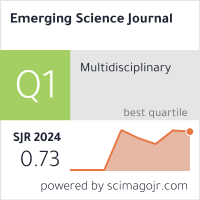Enterprise Resource Planning Systems and Firm Performance: Examining Mediating and Moderating Effects
Downloads
This study examines the impact of Enterprise Resource Planning (ERP) systems on firm performance in Vietnam’s Hotel, Restaurant, and Entertainment sector, with a particular focus on the moderating role of perceived environmental uncertainty (PEU). Utilizing Partial Least Squares Structural Equation Modeling (PLS-SEM) on primary data, the findings reveal that ERP systems significantly improve firm performance through the enhancement of management accounting practices (MAPs). Improved MAPs enable more informed decision-making, efficient resource allocation, and greater operational effectiveness, thereby boosting overall firm performance. Furthermore, PEU moderates the relationship between MAPs and performance, with a more pronounced effect observed in highly uncertain environments. This research contributes to the existing body of knowledge by integrating the Resource-Based View, Contingency Theory, and Technology Diffusion frameworks, addressing a notable gap in ERP literature. The findings provide practical implications for organizations, underscoring the importance of aligning ERP implementation with strategic goals to enhance adaptability in uncertain markets and strengthen overall firm performance.
Downloads
[1] Shtub, A., & Karni, R. (2010). ERP: the dynamics of supply chain and process management. Springer, Berlin, Germany. doi:10.1007/s42452-020-2468-y.
[2] Mohamed, A. (2009). Enterprise Resource Planning (ERP) software suppliers – Essential Guide. Computer Weekly, Sutton, United Kingdom.
[3] Roehl‐Anderson, J. (Ed.). (2012). IT best practices for financial managers (1st ed.). Wiley, New York, United States. doi:10.1002/9781119198819.
[4] Wu, J.-H., & Wang, Y.-M. (2007). Measuring ERP success: The key-users’ viewpoint of the ERP to produce a viable IS in the organization. Computers in Human Behavior, 23(3), 1582–1596.
[5] Alhatabat, Z. (2020). The impact of ERP system’s adoption on management accounting practices in the Jordanian manufacturing companies. International Journal of Business Information Systems, 33(2), 267–284. doi:10.1504/IJBIS.2020.105163.
[6] Mahraz, M.-I., Benabbou, L., & Berrado, A. (2019). Success factors for ERP implementation: A systematic literature review. Proceedings of the International Conference on Industrial Engineering and Operations Management, 415–429.
[7] Sánchez‐Rodríguez, C., & Spraakman, G. (2012). ERP systems and management accounting: A multiple case study. Qualitative Research in Accounting & Management, 9(4), 398–414. doi:10.1108/11766091211282689.
[8] Aktürk, C. (2021). Artificial intelligence in enterprise resource planning systems: A bibliometric study. Journal of International Logistics and Trade, 19(2), 69–82. doi:10.24006/jilt.2021.19.2.069.
[9] Chandra, C. T., & Augustine, Y. (2020). Management control system and ERP with perceived environmental uncertainty as moderating variable towards organizational performance. Eurasia: Economics & Business, 6, 36.
[10] Morawiec, P., & Sołtysik-Piorunkiewicz, A. (2023). ERP system development for business agility in Industry 4.0—A literature review based on the TOE framework. Sustainability, 15(5), Article 5. doi:10.3390/su15054646.
[11] Rom, A., & Rohde, C. (2007). Management accounting and integrated information systems: A literature review. International Journal of Accounting Information Systems, 8(1), 40–68.
[12] Barney, J. (1991). Firm resources and sustained competitive advantage. Journal of Management, 17(1), 99–120.
[13] Donaldson, L. (2001). The contingency theory of organizations. SAGE Publications, Thousand Oaks, United States.
[14] Rogers, E. M. (1983). Diffusion of innovations (3rd ed.). Free Press, New York, United States.
[15] Rogers, E. M., Singhal, A., & Quinlan, M. M. (2014). Diffusion of innovations. An integrated approach to communication theory and research, 432–448. Available online: https://www.taylorfrancis.com/chapters/edit/10.4324/ 9780203887011-36/diffusion-innovations-everett-rogers-arvind-singhal-margaret-quinlan (accessed on May 2025).
[16] Agarwal, R., & Prasad, J. (1997). The role of innovation characteristics and perceived voluntariness in the acceptance of information technologies. Decision Sciences, 28(3), 557–582. doi:10.1111/j.1540-5915.1997.tb01322.x.
[17] Johannessen, J.‑A. (2009). A systemic approach to innovation: The interactive innovation model. Kybernetes, 38(1/2), 158–176.
[18] Bloom, N., Hassan, T. A., Kalyani, A., Lerner, J., & Tahoun, A. (2021). The diffusion of disruptive technologies. National Bureau of Economic Research, NBER. Available online: https://www.nber.org/papers/w28999 (accessed on May 2025).
[19] Abobakr, M. A., Abdel‑Kader, M., & Elbayoumi, A. F. F. (2024). An experimental investigation of the impact of sustainable ERP systems implementation on sustainability performance. Journal of Financial Reporting and Accounting, 207. doi:10.1108/JFRA-04-2023-0207.
[20] Ali, M., & Ahmed, F. (2024). Toward sustainable ERP systems and their impact on individual performance in manufacturing SMEs: Evidence from a North African developing country. International Journal of Emerging Markets, 1102. doi:10.1108/IJOEM-06-2024-1102.
[21] Sivaganthan, S. P., Mukred, M., Mohammed, F., & Leen, M. W. E. (2025). A study on the use of enterprise resource planning to improve the sustainability of Malaysian SMEs. In M. A. Al‑Sharafi, M. Al‑Emran, M. A. Mahmoud, & I. Arpaci (Eds.), Current and future trends on AI applications: Volume 1, 395–409. doi:10.1007/978-3-031-75091-5_21.
[22] Yurtay, Y. (2025). Carbon footprint management with Industry 4.0 technologies and ERP systems in sustainable manufacturing. Applied Sciences, 15(1), 480. doi:10.3390/app15010480.
[23] Penrose, E. T. (2009). The theory of the growth of the firm. Oxford University Press, Oxford, United Kingdom.
[24] Wernerfelt, B. (1984). A resource-based view of the firm. Strategic Management Journal, 5(2), 171–180.
[25] Walker, H., Chicksand, D., Radnor, Z., & Watson, G. (2015). Theoretical perspectives in operations management: An analysis of the literature. International Journal of Operations & Production Management, 35(8), 1182–1206.
[26] Ravichandran, T., Lertwongsatien, C., & Lertwongsatien, C. (2005). Effect of information systems resources and capabilities on firm performance: A resource-based perspective. Journal of Management Information Systems, 21(4), 237–276. doi:10.1080/07421222.2005.11045820.
[27] Chenhall, R. H. (2006). Theorizing contingencies in management control systems research. Handbooks of Management Accounting Research, 1, 163–205.
[28] Cadez, S., & Guilding, C. (2008). An exploratory investigation of an integrated contingency model of strategic management accounting. Accounting, Organizations and Society, 33(7–8), 836–863.
[29] Abdel‑Kader, M., & Luther, R. (2008). The impact of firm characteristics on management accounting practices: A UK‑based empirical analysis. The British Accounting Review, 40(1), 2–27.
[30] Chapman, C. S. (1997). Reflections on a contingent view of accounting. Accounting, Organizations and Society, 22(2), 189–205.
[31] Scapens, R. W. (2006). Understanding management accounting practices: A personal journey. The British Accounting Review, 38(1), 1–30. doi:10.1016/j.bar.2005.10.002.
[32] Scapens, R. W., & Jazayeri, M. (2003). ERP systems and management accounting change: Opportunities or impacts? A research note. European Accounting Review, 12(1), 201–233. doi:10.1080/0963818031000087907.
[33] Momoh, A., Roy, R., & Shehab, E. (2010). Challenges in enterprise resource planning implementation: State-of-the-art. Business Process Management Journal, 16(4), 537–565.
[34] Grabski, S. V., & Leech, S. A. (2007). Complementary controls and ERP implementation success. International Journal of Accounting Information Systems, 8(1), 17–39.
[35] Alsughayer, S. (2024). Role of ERP systems in management accounting in SMEs in Saudi Arabia. Journal of Accounting & Organizational Change, 176. doi:10.1108/JAOC-11-2022-0176.
[36] Booth, P., Matolcsy, Z., & Wieder, B. (2000). The impacts of enterprise resource planning systems on accounting practice – The Australian experience. Australian Accounting Review, 10(22), 4–18. doi:10.1111/j.1835-2561.2000.tb00066.x.
[37] Hyvönen, T., Järvinen, J., & Pellinen, J. (2008). A virtual integration—The management control system in a multinational enterprise. Management Accounting Research, 19(1), 45–61. doi:10.1016/j.mar.2007.08.001.
[38] Spathis, C., & Constantinides, S. (2003). The usefulness of ERP systems for effective management. Industrial Management & Data Systems, 103(9), 677–685. doi:10.1108/02635570310506098.
[39] Astuty, W., Pratama, I., Basir, I., & Harahap, J. P. R. (2022). Does enterprise resource planning lead to the quality of the management accounting information system? Polish Journal of Management Studies, 25. doi:10.17512/pjms.2022.25.2.06.
[40] Pham, N. T., & Pham, X. Q. (2020). Impacts of enterprise resource planning system on the application of management accounting in logistics enterprises located in Ho Chi Minh City. Vietnam Trade and Industry Review, 4.
[41] Nguyen, T. T. P. (2020). Research on factors affecting ERP application and its impact on management accounting in enterprises: Survey in Hanoi city. Journal of Trade Science, 141(2020), 20–29.
[42] Abbasi, S., Zamani, M., & Valmohammadi, C. (2014). The effects of ERP systems implementation on management accounting in Iranian organizations. Education, Business and Society, 7(4), 245–256. doi:10.1108/EBS-03-2014-0020.
[43] Johari, R. J., Alam, M. M., & Said, J. (2018). Assessment of management commitment in Malaysian public sector. Cogent Business & Management, 5(1), 1469955. doi:10.1080/23311975.2018.1469955.
[44] Nikookar, G., Safavi, S. Y., Hakim, A., & Homayoun, A. (2010). Competitive advantage of enterprise resource planning vendors in Iran. Information Systems, 35(3), 271–277. doi:10.1016/j.is.2009.09.002.
[45] Tarigan, Z. J. H., Siagian, H., & Jie, F. (2020). The role of top management commitment to enhancing the competitive advantage through ERP integration and purchasing strategy. International Journal of Enterprise Information Systems (IJEIS), 16(1), 53–68.
[46] Grabski, S. V., Leech, S. A., & Schmidt, P. J. (2011). A Review of ERP Research: A Future Agenda for Accounting Information Systems. Journal of Information Systems, 25(1), 37–78. doi:10.2308/jis.2011.25.1.37.
[47] Umble, E. J., Haft, R. R., & Umble, M. M. (2003). Enterprise resource planning: Implementation procedures and critical success factors. European Journal of Operational Research, 146(2), 241–257. doi:10.1016/s0377-2217(02)00547-7.
[48] Granlund, M., & Malmi, T. (2002). Moderate impact of ERPS on management accounting: A lag or permanent outcome? Management Accounting Research, 13(3), 299–321. doi:10.1006/mare.2002.0189.
[49] Granlund, M., & Mouritsen, J. (2003). Special section on management control and new information technologies. European Accounting Review, 12(1), 77–83. doi:10.1080/0963818031000087925.
[50] Chapman, C. S., & Kihn, L.‑A. (2009). Information system integration, enabling control and performance. Accounting, Organizations and Society, 34(2), 151–169. doi:10.1016/j.aos.2008.07.003.
[51] Ifinedo, P., & Nahar, N. (2006). Quality, impact and success of ERP systems: A study involving some firms in the Nordic‑Baltic region. Journal of Information Technology Impact, 6(1), 19–46.
[52] Somers, T. M., & Nelson, K. G. (2004). A taxonomy of players and activities across the ERP project life cycle. Information & Management, 41(3), 257–278. doi:10.1016/S0378-7206(03)00023-5.
[53] Nah, F. F.‑H., Lau, J. L.‑S., & Kuang, J. (2001). Critical factors for successful implementation of enterprise systems. Business Process Management Journal, 7(3), 285–296. doi:10.1108/14637150110392782.
[54] Wang, E. T. G., Lin, C. C.‑L., Jiang, J. J., & Klein, G. (2007). Improving enterprise resource planning (ERP) fit to organizational process through knowledge transfer. International Journal of Information Management, 27(3), 200–212. doi:10.1016/j.ijinfomgt.2007.02.002.
[55] Timbrell, G., & Gable, G. (2002). The SAP ecosystem: A knowledge perspective. In Enterprise Resource Planning: Solutions and Management (pp. 209–220). IGI Global.
[56] Volkoff, O., & Sawyer, S. (2001). ERP implementation teams, consultants, and information sharing. AMCIS 2001 Proceedings, 202.
[57] Mohd Fuzi, N., Habidin, N. F., Janudin, S. E., & Ong, S. Y. Y. (2019). Critical success factors of environmental management accounting practices: Findings from Malaysian manufacturing industry. Measuring Business Excellence, 23(1), 1–14. doi:10.1108/MBE-03-2018-0015.
[58] Nor, N. M., Bahari, N. A. S., Adnan, N. A., Kamal, S. M. Q. A. S., & Ali, I. M. (2016). The effects of environmental disclosure on financial performance in Malaysia. Procedia Economics and Finance, 35, 117–126. doi:10.1016/S2212-5671(16)00016-2.
[59] Almatrooshi, B., Singh, S. K., & Farouk, S. (2016). Determinants of organizational performance: A proposed framework. International Journal of Productivity and Performance Management, 65(6), 844–859. doi:10.1108/IJPPM-02-2016-0038.
[60] Seal, W. (2006). Management accounting and corporate governance: An institutional interpretation of the agency problem. Management Accounting Research, 17(4), 389–408. doi:10.1016/j.mar.2006.05.001.
[61] Wahyuni, N., & Triatmanto, B. (2020). The effect of the organizational change on company performance mediated by changes in management accounting practices. Accounting, 6(4), 582–588. doi:10.5267/j.ac.2020.4.002.
[62] Bisbe, J., Batista‑Foguet, J.–M., & Chenhall, R. (2007). Defining management accounting constructs: A methodological note on the risks of conceptual misspecification. Accounting, Organizations and Society, 32(7–8), 789–820. doi:10.1016/j.aos.2006.09.010.
[63] Laitinen, E. K. (2014). Influence of cost accounting change on performance of manufacturing firms. Advances in Accounting, 30(1), 230–240. doi:10.1016/j.adiac.2014.03.003.
[64] Gichaaga, P. M. (2014). Effects of management accounting practices on financial performance of manufacturing companies in Kenya (Doctoral dissertation, University of Nairobi), Kenya.
[65] Ahmad, K. (2017). The implementation of management accounting practices and its relationship with performance in small and medium enterprises. International Review of Management and Marketing, 7(1), 342–353.
[66] Maziriri, E. T. (2017). The impact of management accounting practices (MAPs) on the business performance of small and medium enterprises within the Gauteng province of South Africa. Journal of Accounting and Management, 7(2), 12–25.
[67] Tuan, P., Cuong, N. T., & Anh, D. N. P. (2022). The impact of management accounting practices (MAPs) on firm performance: A literature review. International Journal of Auditing and Accounting Studies, 4(2), 211–230. doi:10.47509/IJAAS.2022.v04i02.03.
[68] Otley, D. T. (2016). The contingency theory of management accounting and control: 1980–2014. Management Accounting Research, 31, 45–62. doi:10.1016/j.mar.2016.02.001.
[69] Albright, K. S. (2004). Environmental scanning: Radar for success. Information Management Journal, 38(3), 38–45.
[70] Nguyen, O. T. K., Liu, L. Y. J., Haslam, J., & McLaren, J. (2023). The moderating effect of perceived environmental uncertainty and task uncertainty on the relationship between performance management system practices and organizational performance: Evidence from Vietnam. Production Planning & Control, 34(5), 423–441. doi:10.1080/09537287.2021.1934586.
[71] Gordon, L. A., & Narayanan, V. K. (1984). Management accounting systems, perceived environmental uncertainty and organization structure: An empirical investigation. Accounting, Organizations and Society, 9(1), 33–47. doi:10.1016/0361-3682(84)90028-X.
[72] Govindarajan, V. (1984). Appropriateness of accounting data in performance evaluation: An empirical examination of environmental uncertainty as an intervening variable. Accounting, Organizations and Society, 9(2), 125–135.
[73] Miller, K. D. (1992). A framework for integrated risk management in international business. Journal of International Business Studies, 23(2), 311–331. doi:10.1057/palgrave.jibs.8490270.
[74] Dess, G. G., & Beard, D. W. (1984). Dimensions of organizational task environments. Administrative Science Quarterly, 52–73.
[75] Pfeffer, J., & Salancik, G. R. (1978). The external control of organizations: A resource dependence perspective. SSRN Scholarly Paper No. 1496213.
[76] Thompson, J. D., Zald, M. N., & Scott, W. R. (2017). Organizations in Action. Routledge, New Jersey, United States. doi:10.4324/9781315125930.
[77] Nguyen, D. T. (2011). Research methodology in business (2nd ed.). Finance Publisher, Ho Chi Minh, Vietnam.
[78] DeVellis, R. F., & Thorpe, C. T. (2021). Scale development: Theory and applications (5th ed.). SAGE Publications, California, United States. doi:10.1111/peps.12499.
[79] Bagozzi, R. P., & Yi, Y. (1988). On the evaluation of structural equation models. Journal of the Academy of Marketing Science, 16(1), 74–94. doi:10.1007/BF02723327.
[80] Hair, J. F. Jr., Hult, G. T. M., Ringle, C. M., & Sarstedt, M. (2021). A primer on partial least squares structural equation modeling (PLS‑SEM) (2nd ed.). Sage Publications.
[81] Clark, L. A., & Watson, D. (2016). Constructing validity: Basic issues in objective scale development. Psychological Assessment, 28(5), 1412–1427. doi:10.1037/pas0000626.
[82] Kline, R. B. (2015). Principles and practice of structural equation modeling (4th ed.). Guilford Press, New York, United States.
[83] Fuzi, N. M., Habidin, N. F., Janudin, S. E., & Ong, S. Y. Y. (2019). Environmental management accounting practices, environmental management system and environmental performance for the Malaysian manufacturing industry. International Journal of Business Excellence, 18(1), 120. doi:10.1504/IJBEX.2019.099452.
[84] Alzoubi, A. (2011). The effectiveness of the accounting information system under the enterprise resources planning (ERP). Research Journal of Finance and Accounting, 2(11), 10–19.
[85] Chesoli, J. W. (2017). Assessing the effects of the accounting information system under the enterprise resources planning. Journal of Business Management, 3(6), 83–93. doi:10.53555/bm.v3i6.1384.
[86] Islam, A. K., Corney, M., Mohay, G., Clark, A., Bracher, S., Raub, T., & Flegel, U. (2010). Fraud detection in ERP systems using scenario matching. In K. Rannenberg, V. Varadharajan, & C. Weber (Eds.), Security and Privacy – Silver Linings in the Cloud (Vol. 330, pp. 112–123). Springer Berlin Heidelberg. doi:10.1007/978-3-642-15257-3_11.
[87] Chapman, C. S., Cooper, D. J., & Miller, P. (2009). Accounting, organizations, and institutions: Essays in honour of Anthony Hopwood. OUP Oxford, Oxford, United Kingdom.
[88] Romney, M., Steinbart, P., Mula, J., McNamara, R., & Tonkin, T. (2012). Accounting information systems (Australasian ed.). Pearson Higher Education AU, London, England.
[89] Stratman, J. K., & Roth, A. V. (2002). Enterprise Resource Planning (ERP) competence constructs: Two‑stage multi‑item scale development and validation. Decision Sciences, 33(4), 601–628. doi:10.1111/j.1540-5915.2002.tb01658.x.
[90] Hoque, Z. (2004). A contingency model of the association between strategy, environmental uncertainty and performance measurement: Impact on organizational performance. International Business Review, 13(4), 485–502. doi:10.1016/j.ibusrev.2004.04.003.
[91] Mitchell, F., & Reid, G. C. (2000). Editorial. Problems, challenges and opportunities: the small business as a setting for management accounting research. Management Accounting Research, 11(4), 385–390. doi:10.1006/mare.2000.0152.
[92] Tarigan, Z. J. H. (2018). The impact of organization commitment to process and product innovation in improving operational performance. Doctoral dissertation, Petra Christian University, Surabaya, Indonesia.
[93] Andersén, J., & Samuelsson, J. (2016). Resource organization and firm performance: How entrepreneurial orientation and management accounting influence the profitability of growing and non-growing SMEs. International Journal of Entrepreneurial Behavior & Research, 22(4), 466–484. doi:10.1108/ijebr-11-2015-0250.
- This work (including HTML and PDF Files) is licensed under a Creative Commons Attribution 4.0 International License.




















